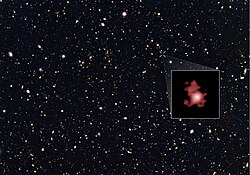References
- ↑ Roman, Nancy G. (1987). "Identification of a constellation from a position". Publications of the Astronomical Society of the Pacific . 99 (617): 695. Bibcode:1987PASP...99..695R. doi: 10.1086/132034 . Constellation record for this object at VizieR.
- 1 2 3 4 5 6 7 8 Vallenari, A.; et al. (Gaia collaboration) (2023). "Gaia Data Release 3. Summary of the content and survey properties". Astronomy and Astrophysics. 674: A1. arXiv: 2208.00211 . Bibcode:2023A&A...674A...1G. doi: 10.1051/0004-6361/202243940 . S2CID 244398875. Gaia DR3 record for this source at VizieR.
- 1 2 3 Kovács, Géza; Hartman, Joel D.; Bakos, Gáspár Á.; Quinn, Samuel N.; Penev, Kaloyan; Latham, David W.; Bhatti, Waqas; Csubry, Zoltán; De Val-Borro, Miguel (2014). "Stellar rotational periods in the planet hosting open cluster Praesepe". Monthly Notices of the Royal Astronomical Society. 442 (3): 2081. arXiv: 1405.3728 . Bibcode:2014MNRAS.442.2081K. doi: 10.1093/mnras/stu946 .
- ↑ Allen, Lori E.; Strom, Karen M. (1995). "Moderate-Resolution Spectral Standards from lambda5600 to lambda9000 angstrom". The Astronomical Journal. 109: 1379. Bibcode:1995AJ....109.1379A. doi:10.1086/117370.
- 1 2 3 Quinn, Samuel N.; White, Russel J.; Latham, David W.; Buchhave, Lars A.; Cantrell, Justin R.; Dahm, Scott E.; Fűrész, Gabor; Szentgyorgyi, Andrew H.; Geary, John C.; Torres, Guillermo; Bieryla, Allyson; Berlind, Perry; Calkins, Michael C.; Esquerdo, Gilbert A.; Stefanik, Robert P. (2012). "Two 'b's in the Beehive: The Discovery of the First Hot Jupiters in an Open Cluster". The Astrophysical Journal. 756 (2): L33. arXiv: 1207.0818 . Bibcode:2012ApJ...756L..33Q. doi:10.1088/2041-8205/756/2/L33. S2CID 118825401.
- 1 2 3 Cutri, R. M.; Skrutskie, M. F.; Van Dyk, S.; Beichman, C. A.; Carpenter, J. M.; Chester, T.; Cambresy, L.; Evans, T.; Fowler, J.; Gizis, J.; Howard, E.; Huchra, J.; Jarrett, T.; Kopan, E. L.; Kirkpatrick, J. D.; Light, R. M.; Marsh, K. A.; McCallon, H.; Schneider, S.; Stiening, R.; Sykes, M.; Weinberg, M.; Wheaton, W. A.; Wheelock, S.; Zacarias, N. (2003). "VizieR Online Data Catalog: 2MASS All-Sky Catalog of Point Sources (Cutri+ 2003)". Vizier Online Data Catalog. Bibcode:2003yCat.2246....0C.
- 1 2 3 4 5 Malavolta, L.; et al. (2016), "The GAPS programme with HARPS-N at TNG. XI. Pr 0211 in M 44: the first multi-planet system in an open cluster", Astronomy & Astrophysics, 588: A118, arXiv: 1602.00009 , Bibcode:2016A&A...588A.118M, doi:10.1051/0004-6361/201527933, S2CID 119207951
- ↑ "Cl* NGC 2632 JC 278". SIMBAD . Centre de données astronomiques de Strasbourg . Retrieved 9 December 2023.
- 1 2 Mugrauer, M. (December 2019). "Search for stellar companions of exoplanet host stars by exploring the second ESA-Gaia data release". Monthly Notices of the Royal Astronomical Society . 490 (4): 5088–5102. Bibcode:2019MNRAS.490.5088M. doi: 10.1093/mnras/stz2673 .
- ↑ "Pr0211". NASA Exoplanet Archive . Retrieved 9 December 2023.
- ↑ "Cl* NGC 2632 JC 280". SIMBAD . Centre de données astronomiques de Strasbourg . Retrieved 9 December 2023.
- 1 2 3 Fazekas, Andrew (2012-09-21). "New Planets Found in Star Cluster - Would Have Dazzling Nights". National Geographic News. NATIONAL GEOGRAPHIC. Archived from the original on September 23, 2012. Retrieved 2016-05-30.
- 1 2 "Planet Pr 0211 b". Extrasolar Planets Encyclopaedia . Retrieved 2016-04-18.
- 1 2 "Planet Pr 0211 c". Extrasolar Planets Encyclopaedia . Retrieved 2016-04-18.


